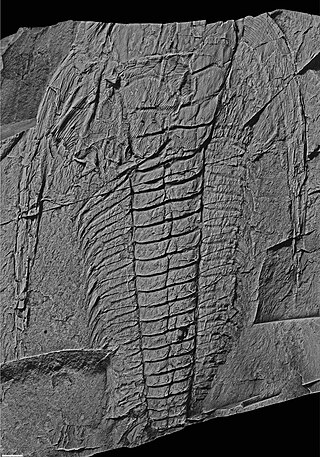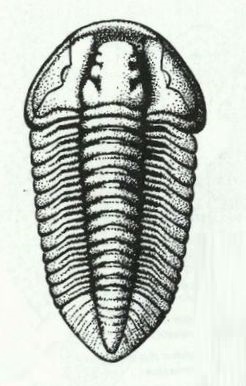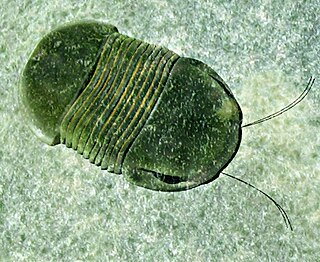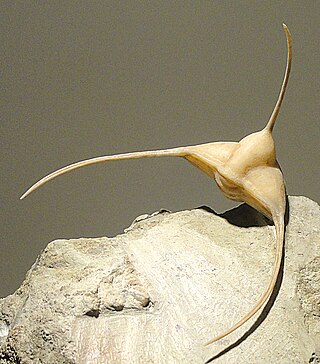
Asaphus kowalewskii is one of the 35 species of trilobites of the genus Asaphus. Fossils of this species are popular among collectors because of their prominent stalked eyes, many an inch or more in length.

John William Salter was an English naturalist, geologist, and palaeontologist.

The Phacopina comprise a suborder of the trilobite order Phacopida. Species belonging to the Phacopina lived from the Lower Ordovician (Tremadocian) through the end of the Upper Devonian (Famennian). The one unique feature that distinguishes Phacopina from all other trilobites are the very large, separately set lenses without a common cornea of the compound eye.

Isotelus is a genus of asaphid trilobites from the Middle and Late Ordovician Period, fairly common in the northeastern United States, northwest Manitoba, southwestern Quebec and southeastern Ontario.
Ceraurinella is an extinct genus of trilobite in the family Cheiruridae. There are about 19 described species in Ceraurinella.

Flexicalymene Shirley, 1936. is a genus of trilobites belonging to the order Phacopida, suborder Calymenina and Family Calymenidae. Flexicalymene specimens can be mistaken for Calymene, Gravicalymene, Diacalymene and a few other Calymenina genera. They are used as an index fossil in the Ordovician. Ohio and North America are particularly known for being rich with Flexicalymene fossils.

Sphaerexochus is a genus of trilobite from the Middle Ordovician to Late Silurian of Asia, Australia, Europe, and North America.
Atractopyge is a genus of trilobites that lived in what would be Asia and Europe from the middle Ordovician to the early Devonian from 472 to 412.3 mya, existing for approximately 59.7 million years.
Calyptaulax is a genus of trilobites in the order Phacopida that existed during the middle and upper Ordovician in what is now the U.S. states of New York, Oklahoma, Illinois, Missouri, Virginia, Vermont, Nevada, Iowa, Wisconsin, Kentucky, and Iowa, as well as the Canadian provinces of Ontario, Newfoundland and Labrador, Quebec, and the territory of Nunavut. Other countries Calyptaulax fossils are known from include Ireland, Norway, Russia, and the United Kingdom.

Lonchodomas is a genus of trilobites, that lived during the Ordovician. It was eyeless, like all raphiophorids, and had a long straight sword-like frontal spine, that gradually transforms into the relatively long glabella. Both the glabellar spine and the backward directed genal spines are subquadrate in section. Lonchodomas has five thorax segments and the pleural area of the pygidium has two narrow furrows. Lonchodomas occurred in what are today Argentina, Canada (Newfoundland), Estonia, Latvia, Norway, Sweden, the Russian Federation and the United States.

Bumastus is an extinct genus of corynexochid trilobites which existed from the Early Ordovician period to the Late Silurian period. They were relatively large trilobites, reaching a length of 6 in (15 cm). They were distinctive for their highly globular, smooth-surfaced exoskeleton. They possessed well-developed, large compound eyes and were believed to have dwelled in shallow-water sediments in life.

Geragnostus is a genus of very small agnostid trilobites whose fossils are found Ordovician-aged marine strata from Eurasia, North America and Argentina.

Cyclopygidae is a family of asaphid trilobites from the Ordovician. Cyclopygids had an extratropical distribution, and there is evidence that they lived in darker parts of the water column. Cyclopygids are characterized by enlarged eyes, with a wide angle of view, both horizontal and vertical, reminiscent of the eyes of dragonflies. These typically touch the glabella directly on the side. Cyclopygids all lack genal spines, but Symphysops carries a forward directed frontal spine on the glabella. It is presumed that at least the members of the genus Pricyclopyge swam upside down and had bioluminescent organs on the third thorax segment. Cyclopygids had between 7 and 5 thorax segments, a wide and stout axis, and short side lobes.

Raphiophoridae is a family of small to average-sized trilobites that first occurred at the start of the Ordovician and became extinct at the end of the Middle Silurian.

The Illaenidae are a family of trilobites in the order Corynexochida. 223 currently accepted species in 24 genera are known from the Ordovician. Some scholars include the Panderiidae in the Illaenidae, but this is not generally supported.

Illaenus tauricornis is a species of trilobites from Russia and Morocco, from the middle Ordovician.

Illaenus crassicauda is a species of trilobites belonging to the family Illaenidae. These trilobites lived in the middle Ordovician and in the Silurian age. Fossils of this species have been found in the sediments of Sweden and Russia.

Librostoma is a subclass of trilobites defined by having a natant hypostome, which is a hypostome that is free from the anterior doublure and aligned with the anterior of the glabella, this is unlike a conterminant hypostome, which is attached to the exoskeleton.

Typhlokorynetes plana is a species of small, button-shaped asaphid trilobites of the family Raphiophoridae that lived during the Early Tremadocian of Vermont, United States.

Thaleops is an extinct genus of trilobite of the family Illaenidae. It lived from the Floian to the Katian of the Ordovician in what is now North America. Thaleops can be told apart from other illaenids because of the cheek spines that many species possess under their eyes. Thaleops had a large distribution range, With some species being found in parts of Canada to some U.S states including Oklahoma, Wisconsin, and New York. It is thought to have lived in shallow water, as a study published in Oklahoma found that deposits that contained Thaleops and the asaphid trilobite Bumastides contained 4 times as many trilobite genera, where associated with shallow water areas.

















